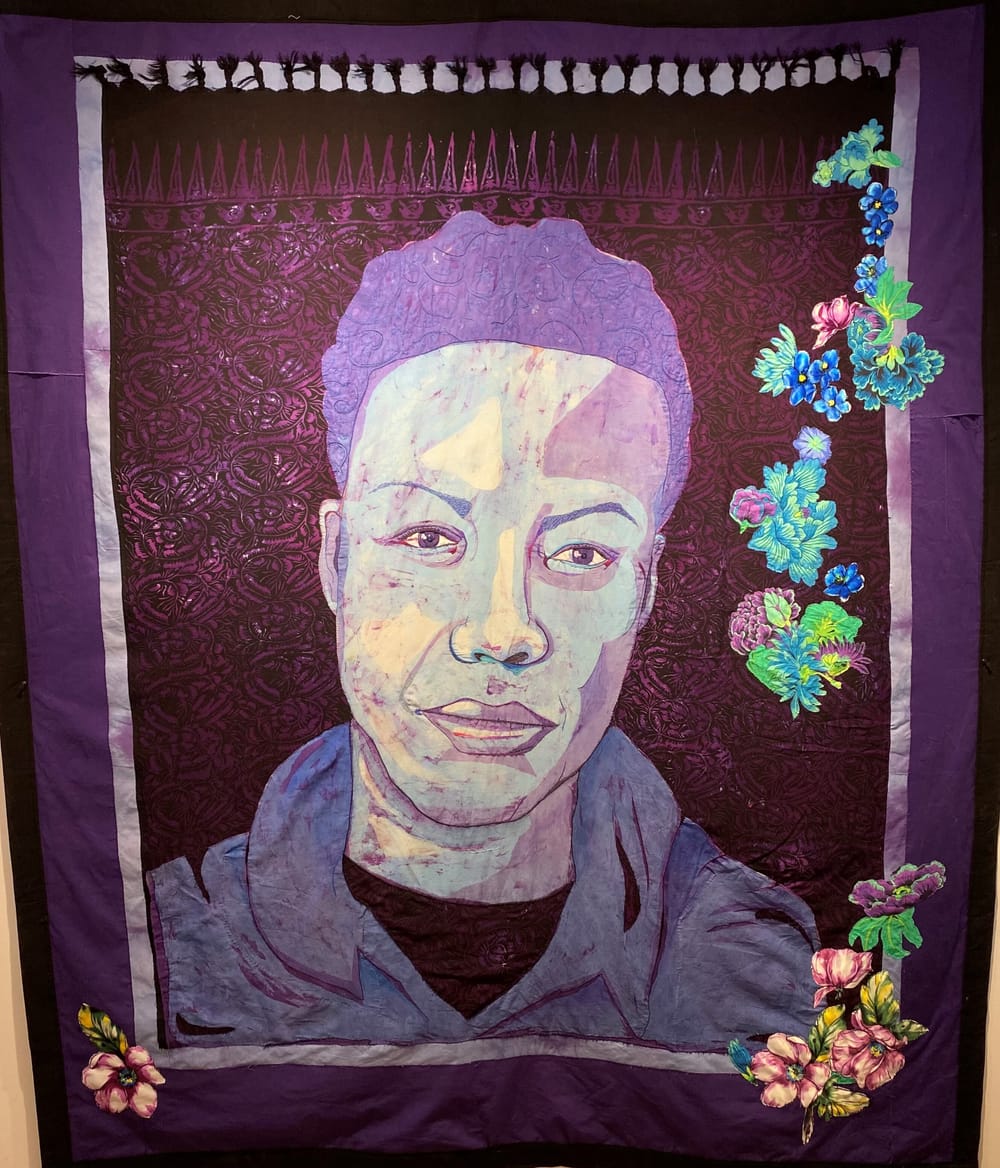Stay in the Loop
BSR publishes on a weekly schedule, with an email newsletter every Wednesday and Thursday morning. There’s no paywall, and subscribing is always free.
Visibility can be a lifeline
MUSE Gallery presents Seeking Freedom: Portraits of Mass Incarceration

Seven large portraits, created in batik, quilting, and embroidery by textile artist Carolyn Harper, form a dramatic exhibition at MUSE Gallery in Old City. Most of the works show only the models’ heads, and their larger-than-life eyes stare compellingly back at viewers. Wall texts, written by Harper in collaboration with the sitters, tell the stories of these currently and formerly incarcerated people.
Tanisha was forced by an armed housemate to take part in a murder. She voluntarily came to the police, identified the killer and helped to convict him, but was given no leniency and is serving a prison sentence of 20 to 40 years. Her portrait may be the most successful in the show; it feels the most natural in spite of the difficult medium. Creating a portrait in quilt form, even when embellished by embroidery, forces artists to reduce faces to segments and planes. It’s nearly impossible to convey a sense of movement or gesture, and Harper, who earned her master’s degree in fine arts at the University of Pennsylvania, has managed to work magic with Tanisha (2022). It’s a warm piece with subtle facial angles and a natural expression.
William, Don, and Jahmir
Another success is William (2022), who is portrayed looking up to the right rather than directly at the viewer. He was 17 when he attempted a robbery at gunpoint; his victim was an off-duty police officer who shot at William 15 times, hitting him in the knee. William was tried and sentenced as an adult and served 31 years. Paroled in 2018, he runs a reentry support program called Life After Next for returning citizens and is a member of the sentencing commission’s reentry council in San Francisco.
On the gallery’s right wall, Don (2022-23) shows a man with glasses, his head and torso appliquéd onto a silkscreened tapestry of Philadelphia’s skyline. Don can be seen clearly from the street through MUSE Gallery’s nearly floor-to-ceiling windows, and the portrait’s open, welcoming expression brings people in the door.
An ambitious group portrait, Jahmir and Family (2021-23) nearly covers the entire wall across from Don. The largest piece in the show, Jahmir and Family is 12 feet in height; the lower section is draped across the floor. Harper hasn’t quite completed sewing it, so the artwork is a little rough around the edges and still pinned in places.
Opportunities to learn
Seeking Freedom’s presentation may not be pristine, but it works. Harper has created an installation that is part art show, part grassroots activist center. The windowsill, shelves, and benches are covered with printed copies of studies and news stories about wrongful convictions and other failings of the American legal system. In a corner, a small bookcase is stocked with books, including Solitary (2019) by Albert Woodfox and Privilege and Punishment: How Race and Class Matter in Criminal Court (2020) by Matthew Clair. The informal atmosphere and stacks of literature make for a comfortable place to spend time browsing and reading.
Atop the bookshelf are postcards, paper, postage stamps, and suggested text for visitors who want to join a mail-in campaign to help Tanisha (convicted in 2010) get parole or a sentence commutation. Handouts include a list of websites for nine organizations that work to build community and connections between incarcerated people and those on the outside, including the Philadelphia-based Sista2Sista Soul2Soul arts project.
On Saturday, June 24, at 2pm, Termaine Hicks, exonerated in 2020 with help from the Innocence Project after serving 19 years in prison, will speak at the gallery. Later this year, the exhibition will travel to Indiana, then to Colorado in 2024; more locations are being added. After the show’s tour ends, Harper says in her artist’s statement, the artworks will be given to the people they portray.
The quantity of news stories stacked around the gallery helps to visually communicate that individual people’s lives, and those of their families, add up to the mind-numbing statistics of America’s prison-industrial complex. The artworks, which can come across in photographs as a little simplistic, gain heft in the gallery and, as a group, they are powerful. Once seen, these people’s faces are unforgettable.
Above: Carolyn Harper’s Tanisha (2022), on view at MUSE Gallery. (Photo courtesy of the artist.)
What, When, Where
Seeking Freedom: Portraits of Mass Incarceration. Through July 2, 2023, at MUSE Gallery, 52 N 2nd Street, Philadelphia. (215) 627-5310 or musegalleryphiladelphia.com.
Accessibility
There is a low step, and visitors must navigate around a narrow pillar, at MUSE Gallery’s entrance. For more information, call (215) 627-5310.
Sign up for our newsletter
All of the week's new articles, all in one place. Sign up for the free weekly BSR newsletters, and don't miss a conversation.

 Emily Schilling
Emily Schilling